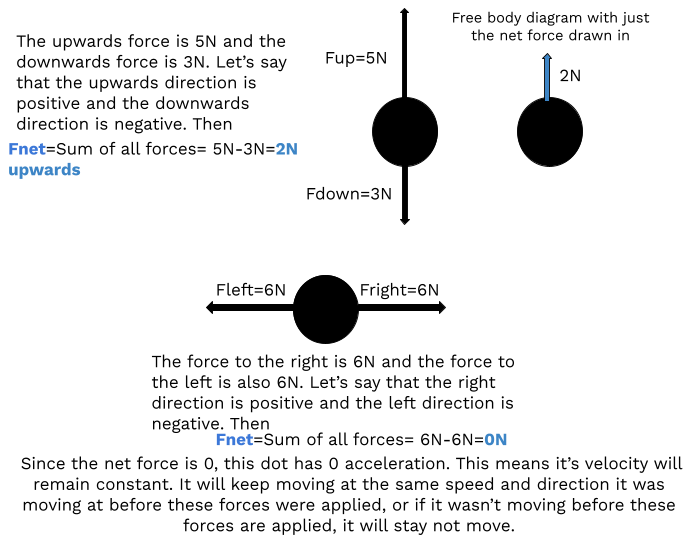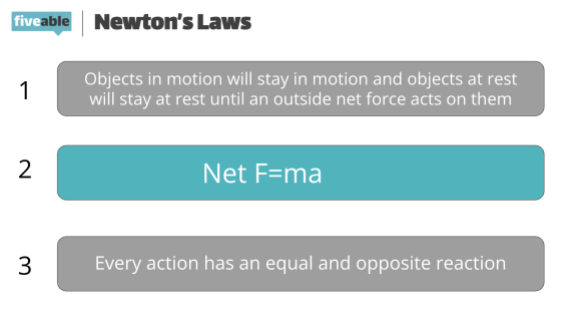
Newton's 1st Law
6 min read•december 6, 2021
Briana Dokken
Briana Dokken
An Object at Rest Stays at Rest.. but why? External Forces and Motion.
You’ve probably heard of Isaac Newton before. Maybe you’ve heard an apple fell on his head and he “invented” gravity. Maybe you are angry (or happy) with him for coming up with calculus. Newton did a lot of interesting things in math and physics, and one of the biggest contributions were his three laws of physics, which we cleverly call Newton’s 1st, 2nd, and 3rd laws. In this article we’ll go over the basics of forces, and then we’ll talk about Newton’s 1st Law.
Forces
Newton’s three laws describe forces: pushes or pulls that cause objects to accelerate. Forces can act on an object by touching it (contact forces), like the force you apply to a door when you push it open. Forces can also act on objects without touching them (field forces), like how a ball flying through the air experiences a force of gravity from the earth that makes it accelerate downwards. In physics, we like to draw free body diagrams to show what forces are acting on an object:
Free Body Diagrams
Let’s take a look at how free body diagrams work with an example. We’ll say that there is a kid bouncing a basketball in a gym. We will draw a free body diagram of the basketball when it is in the air being pushed on by the kid’s hand, and we’ll draw another free body diagram of the basketball when it is touching the ground after falling down from the kid’s hand.
When making free body diagrams (FBDs), we start by drawing a dot to represent the object we’re looking at. Then, we draw arrows that start on the dot and point away from the dot to represent the forces acting on the object. After that we add labels to our arrows to know which force each stands for.
Here’s how we would make the free body diagram for the basketball when it is in the air being pushed down by the kid’s hand:

Here’s a free body diagram of the ball right when it hits the floor:

Newton’s First Law
Now that you have some background information on what a force is, what is Newton’s First Law? Newton’s First Law describes that every object will continue to move in the same direction at the same speed, unless a net external force acts on it. In other words, an object will move with a constant velocity, until a net outside force acts on it. To understand what this means in physics, there are a few terms you have to know:
Velocity
The speed and direction towards which an object moves is velocity. Velocity is considered a vector quantity because it has both a magnitude (speed) and a direction. Some examples of velocity are:
4 meters per second (m/s) north
10m/s up
-7 m/s (the negative sign can indicate the direction if you set one direction as positive and one as negative).
Acceleration
The rate that velocity changes at, or the change in velocity over time, is acceleration. So, acceleration is the first derivative of velocity.
Acceleration represents how velocity is changing, so an object with acceleration might be slowing down, speeding up, or changing the direction it is moving at a constant speed. Since velocity includes both speed and direction, a change in velocity (acceleration) can mean that the speed of the object is changing, the direction the object moves in is changing, or both.
Want to learn more about acceleration and velocity? Check out this video!
Net Force
The net force on an object is the sum of all the forces acting on an object. Net force describes the overall force acting on an object. Net force is also a vector quantity because it has both a magnitude and direction. Here are two examples of net force:

External vs Internal Forces
An external force is a force acting on a system that comes from something outside that system. An internal force is a force that comes from one part of a system and acts on another part of that system.
For example, let’s say Susy and Bill are on rollerblades and are facing each other. Susy and Bill each push each other at the same time. If we define just Susy as the system we are looking at, then Bill’s push is an external force acting on Susy. It is a push acting on the system (Susy) coming from something outside the system (Bill). However, if we define the system as being both Susy and Bill, Bill’s force on Susy counts as an internal force. It is a push coming from one part of the system (Bill) that acts on another part of the system (Susy).
Notice how defining the system a certain way can change how we view the forces acting upon an object. Just like with the rest of life, perspective changes things! The cool thing about physics is that we can define parameters and systems that make it easier to solve for what we’re looking for.
Keep in mind that external forces come from outside systems and internal forces act within systems.
Inertia
Newton’s First Law is also called the “Law of Inertia”, because it describes that all matter has inertia. Inertia is matter’s tendency to avoid changes in motion. An object with a greater will be more resistant to changes in motion. For example, a huge couch that isn’t moving is really hard to push, or apply a force to, so we can say the couch exhibits lots of inertia. However, a pencil is relatively easy to push and move. That means we can say a pencil has a smaller amount of inertia.
Practice Problems!
Use what you just learned about Newton’s 1st Law to solve these problems!
Forces and Free Body Diagrams
Bob and Sue are fighting over the last piece of pizza. Bob pulls on the slice of pizza with a force of 3N to the left, and Sue pulls on the slice of pizza with a force of 2N to the right. Draw a free body diagram of the piece of pizza.
You accidentally left a pair of headphones on the ground. Your dog loves to eat your headphones. Both you and your dog grab the headphones at the same time. You pull with a force of 4N to the left and your dog pulls with a force of 5N to the right. Draw a free body diagram of the headphones. Add an arrow approximating the direction that the net force on the headphones points in.
Answers!
1.

2.

Newton’s First Law
Will these objects represented by free body diagrams have an acceleration?
1.

2.

Answers
No. The forces going up and down are equal but in opposite directions, so they cancel out. The forces going left and right are equal but in opposite directions, so they also cancel each other out. This means that the net external force on the object is 0. No net external force means 0 acceleration.
Yes. The net external force on the object is 3N to the right, so the object will experience an acceleration pointing to the right.
What to Know
To summarize, Newton’s First Law says that objects move at a constant velocity (at a constant speed and in the same direction) unless a net external force (all of the external forces acting on an object added up do not equal 0) acts on it. Net external forces cause an acceleration (a change of velocity) on objects.

You might see this law simply summarized as such: what is in motion stays in motion and what is at rest stays at rest.
Check out these articles if you’re interested in learning about Newton’s 2nd and 3rd Laws, or look at the picture below to get a sneak peak of what those laws describe!

🤝Connect with other students studying Physics with Hours!
Newton's 1st Law
6 min read•december 6, 2021
Briana Dokken
Briana Dokken
An Object at Rest Stays at Rest.. but why? External Forces and Motion.
You’ve probably heard of Isaac Newton before. Maybe you’ve heard an apple fell on his head and he “invented” gravity. Maybe you are angry (or happy) with him for coming up with calculus. Newton did a lot of interesting things in math and physics, and one of the biggest contributions were his three laws of physics, which we cleverly call Newton’s 1st, 2nd, and 3rd laws. In this article we’ll go over the basics of forces, and then we’ll talk about Newton’s 1st Law.
Forces
Newton’s three laws describe forces: pushes or pulls that cause objects to accelerate. Forces can act on an object by touching it (contact forces), like the force you apply to a door when you push it open. Forces can also act on objects without touching them (field forces), like how a ball flying through the air experiences a force of gravity from the earth that makes it accelerate downwards. In physics, we like to draw free body diagrams to show what forces are acting on an object:
Free Body Diagrams
Let’s take a look at how free body diagrams work with an example. We’ll say that there is a kid bouncing a basketball in a gym. We will draw a free body diagram of the basketball when it is in the air being pushed on by the kid’s hand, and we’ll draw another free body diagram of the basketball when it is touching the ground after falling down from the kid’s hand.
When making free body diagrams (FBDs), we start by drawing a dot to represent the object we’re looking at. Then, we draw arrows that start on the dot and point away from the dot to represent the forces acting on the object. After that we add labels to our arrows to know which force each stands for.
Here’s how we would make the free body diagram for the basketball when it is in the air being pushed down by the kid’s hand:

Here’s a free body diagram of the ball right when it hits the floor:

Newton’s First Law
Now that you have some background information on what a force is, what is Newton’s First Law? Newton’s First Law describes that every object will continue to move in the same direction at the same speed, unless a net external force acts on it. In other words, an object will move with a constant velocity, until a net outside force acts on it. To understand what this means in physics, there are a few terms you have to know:
Velocity
The speed and direction towards which an object moves is velocity. Velocity is considered a vector quantity because it has both a magnitude (speed) and a direction. Some examples of velocity are:
4 meters per second (m/s) north
10m/s up
-7 m/s (the negative sign can indicate the direction if you set one direction as positive and one as negative).
Acceleration
The rate that velocity changes at, or the change in velocity over time, is acceleration. So, acceleration is the first derivative of velocity.
Acceleration represents how velocity is changing, so an object with acceleration might be slowing down, speeding up, or changing the direction it is moving at a constant speed. Since velocity includes both speed and direction, a change in velocity (acceleration) can mean that the speed of the object is changing, the direction the object moves in is changing, or both.
Want to learn more about acceleration and velocity? Check out this video!
Net Force
The net force on an object is the sum of all the forces acting on an object. Net force describes the overall force acting on an object. Net force is also a vector quantity because it has both a magnitude and direction. Here are two examples of net force:

External vs Internal Forces
An external force is a force acting on a system that comes from something outside that system. An internal force is a force that comes from one part of a system and acts on another part of that system.
For example, let’s say Susy and Bill are on rollerblades and are facing each other. Susy and Bill each push each other at the same time. If we define just Susy as the system we are looking at, then Bill’s push is an external force acting on Susy. It is a push acting on the system (Susy) coming from something outside the system (Bill). However, if we define the system as being both Susy and Bill, Bill’s force on Susy counts as an internal force. It is a push coming from one part of the system (Bill) that acts on another part of the system (Susy).
Notice how defining the system a certain way can change how we view the forces acting upon an object. Just like with the rest of life, perspective changes things! The cool thing about physics is that we can define parameters and systems that make it easier to solve for what we’re looking for.
Keep in mind that external forces come from outside systems and internal forces act within systems.
Inertia
Newton’s First Law is also called the “Law of Inertia”, because it describes that all matter has inertia. Inertia is matter’s tendency to avoid changes in motion. An object with a greater will be more resistant to changes in motion. For example, a huge couch that isn’t moving is really hard to push, or apply a force to, so we can say the couch exhibits lots of inertia. However, a pencil is relatively easy to push and move. That means we can say a pencil has a smaller amount of inertia.
Practice Problems!
Use what you just learned about Newton’s 1st Law to solve these problems!
Forces and Free Body Diagrams
Bob and Sue are fighting over the last piece of pizza. Bob pulls on the slice of pizza with a force of 3N to the left, and Sue pulls on the slice of pizza with a force of 2N to the right. Draw a free body diagram of the piece of pizza.
You accidentally left a pair of headphones on the ground. Your dog loves to eat your headphones. Both you and your dog grab the headphones at the same time. You pull with a force of 4N to the left and your dog pulls with a force of 5N to the right. Draw a free body diagram of the headphones. Add an arrow approximating the direction that the net force on the headphones points in.
Answers!
1.

2.

Newton’s First Law
Will these objects represented by free body diagrams have an acceleration?
1.

2.

Answers
No. The forces going up and down are equal but in opposite directions, so they cancel out. The forces going left and right are equal but in opposite directions, so they also cancel each other out. This means that the net external force on the object is 0. No net external force means 0 acceleration.
Yes. The net external force on the object is 3N to the right, so the object will experience an acceleration pointing to the right.
What to Know
To summarize, Newton’s First Law says that objects move at a constant velocity (at a constant speed and in the same direction) unless a net external force (all of the external forces acting on an object added up do not equal 0) acts on it. Net external forces cause an acceleration (a change of velocity) on objects.

You might see this law simply summarized as such: what is in motion stays in motion and what is at rest stays at rest.
Check out these articles if you’re interested in learning about Newton’s 2nd and 3rd Laws, or look at the picture below to get a sneak peak of what those laws describe!

🤝Connect with other students studying Physics with Hours!

Resources
© 2024 Fiveable Inc. All rights reserved.
AP® and SAT® are trademarks registered by the College Board, which is not affiliated with, and does not endorse this website.